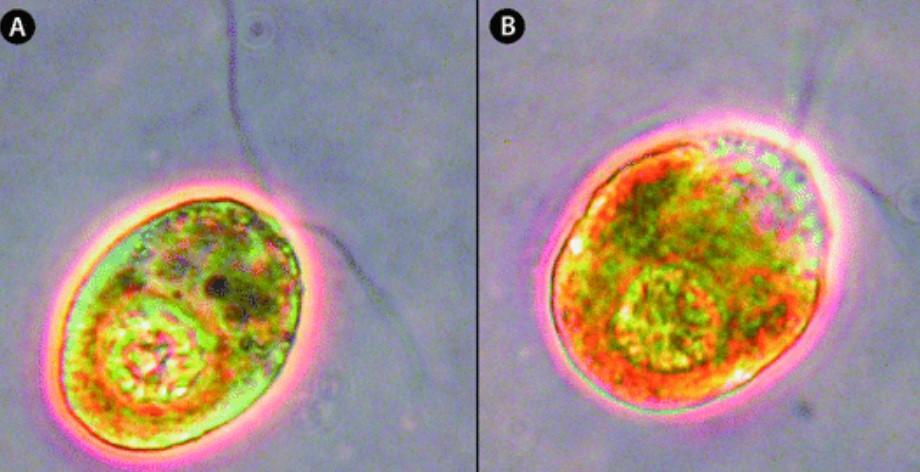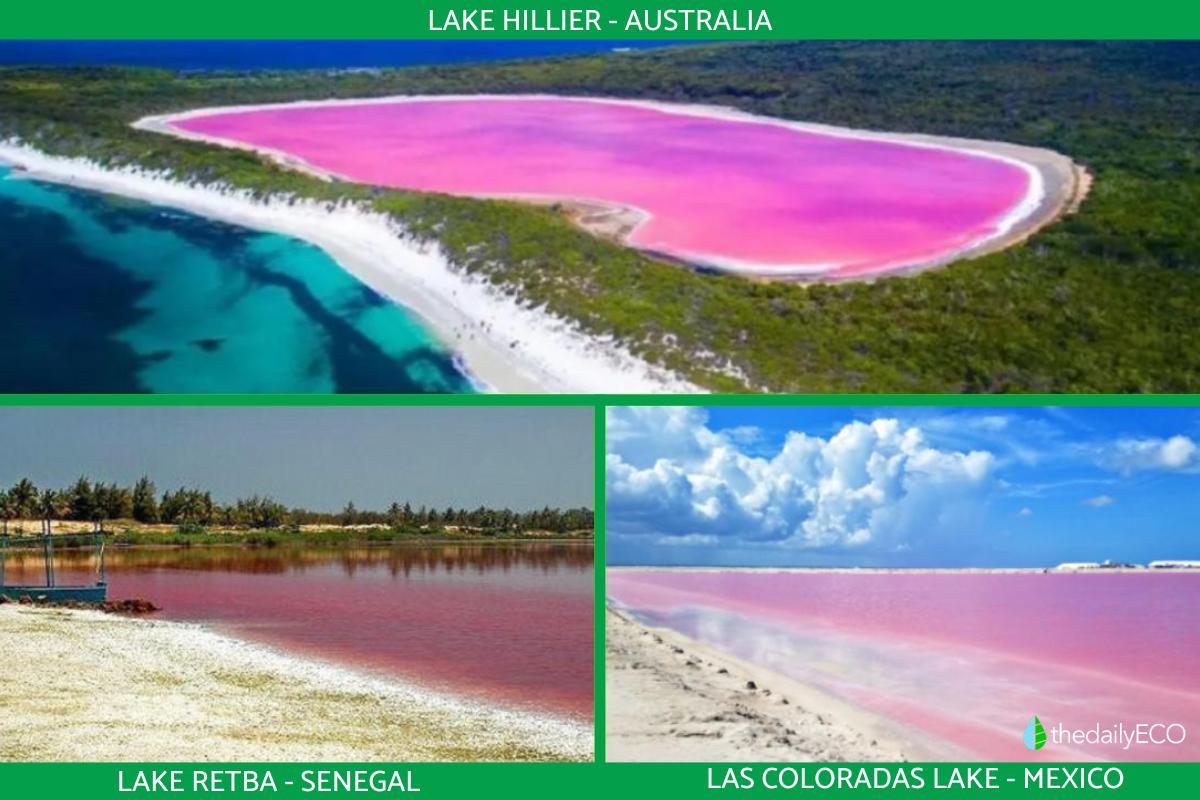What Are Pink Lakes? - Definition, Location and Ecological Importance


The captivating pink hues of pink lakes emerge due to the presence of microscopic organisms that flourish in these high-salinity environments. These tiny life forms produce carotenoid pigments, including beta-carotene, which give the lakes their characteristic pink color. Ranging from delicate blush to vibrant fuchsia, these natural wonders showcase nature's artistry and the incredible diversity of Earth's ecosystems.
The following article by thedailyECO explains what pink lakes are, the science behind their mesmerizing hues, their ecological significance, and their global distribution.
What are pink lakes?
Pink lakes are natural bodies of water that exhibit a pink or reddish hue due to the presence of certain microorganisms, primarily salt-tolerant algae and halobacteria. They play a crucial role in the ecology of pink lakes, serving as primary producers.
These microorganisms produce carotenoid pigments, such as beta-carotene, which impart the characteristic pink color to the lake water. The intensity of the pink color can vary depending on the concentration of these microorganisms, the salinity of the water, and the angle of sunlight.
For example, when sunlight hits the lake's surface, the carotenoid pigments absorb certain wavelengths of light, reflecting the reddish-pink hues that we perceive. The higher the concentration of these pigments, the more vibrant the pink color appears.
Source: ResearchGate

Ecological role of pink lakes
Pink lakes play a fascinating ecological role, far beyond their striking appearance. Let's delve deeper into the significance of these unique ecosystems:
- Microbial diversity: pink lakes are essentially saline environments, often too harsh for most aquatic life. However, microorganisms like bacteria, archaea, and algae have adapted to thrive in these extreme conditions. These microorganisms are critical players in pink lake ecosystems, forming the base of the food chain.
- Algae and photosynthesis: within these salt-loving microorganisms, pink lakes often host specific strains of halophilic algae. These algae are adept at photosynthesis even in highly saline waters, making them primary producers in the ecosystem. Through photosynthesis, they convert sunlight into energy, helping to sustain life in the lake.
- High salinity tolerance: these lakes boast salinity levels that would be inhospitable to most other life forms. The extreme salt concentration discourages predators and competitors, providing a haven for the microorganisms that have evolved to thrive there.
- Biodiversity: the diversity of these microorganisms goes beyond their color. Each strain contributes to the unique chemistry and ecology of the lake. Some produce pigments, like the red carotenoids, that give the water its rosy hue. Others are involved in biogeochemical processes that cycle important elements, such as sulfur and nitrogen.
- Nitrogen fixation: in some pink lakes, nitrogen-fixing cyanobacteria play a crucial role. These microorganisms take atmospheric nitrogen and convert it into ammonia, which is then used by other life forms in the ecosystem. This process is vital for maintaining nutrient cycles in these extreme environments.
- Rare microbes: pink lakes are also home to some exceptionally rare microbial species. The adaptation of these microorganisms to such extreme conditions has led to the evolution of unique metabolic pathways and ecological roles not found in more conventional aquatic ecosystems.
- Contribution to global understanding: understanding the microbial communities in pink lakes not only enriches our knowledge of these specialized environments but also provides insights into broader ecological and biogeochemical processes. Lessons learned from studying pink lakes can have implications for understanding microbial life in other extreme environments on Earth and even on other planets.
Delve into the fascinating distinctions between lakes and lagoons with this other article.
How many pink lakes are there in the world?
The exact number of pink lakes in the world is difficult to determine as new ones are being discovered and some may exist in remote or unexplored regions. However, estimates suggest that there are at least 29 known pink lakes around the globe. These lakes are found on various continents, including Australia, Africa, Europe, and North America.
It is important to note that the number of pink lakes may fluctuate over time due to changes in environmental conditions, such as salinity levels, nutrient availability, and climate patterns.
These factors can influence the growth and abundance of the microorganisms responsible for the pink coloration, leading to variations in the intensity of the pink hue or even the disappearance of the pink color altogether.
Uncover the mystery behind the captivating phenomenon of pink snow, also known as watermelon snow, with this other article.

Names and locations of pink lakes
Pink lakes, with their captivating pink or reddish hues, are scattered across various parts of the world, each with unique characteristics and charm. Here's a more toned-down description of some renowned pink lakes:
Lake Hillier
On Middle Island, off the coast of Western Australia, Lake Hillier stands out with its vibrant pink color. Surrounded by greenery and contrasting with the blue ocean, Lake Hillier is a natural spectacle. Its high salinity and the presence of Dunaliella salina, a salt-loving algae, contribute to its pink hue. The lake is best viewed from above, offering breathtaking panoramas.
Lake Retba
North of Dakar, Senegal, Lake Retba is known for its captivating pink waters, especially during the dry season. The lake's high salinity creates an ideal habitat for Dunaliella salina, the algae responsible for the pink pigment. The lake is also known for its traditional salt harvesting, creating a picturesque scene against the pink waters.
Lake Las Coloradas
Las Coloradas, situated in the Yucatán Peninsula of Mexico, is a natural marvel celebrated for its enchanting color metamorphosis, painting the landscape with hues ranging from delicate pink to intense red. This mesmerizing transformation is a result of the lake's high salinity and the thriving community of halophilic microorganisms, with the vivid Dunaliella salina taking the lead. The most awe-inspiring spectacle at Las Coloradas unfolds during sunsets, when the waters come alive with their most vivid and captivating red and pink shades.
Hutt Lagoon
Near the town of Gregory in Western Australia, Hutt Lagoon is a large pink lake that changes color depending on the time of day and cloud cover. The lake's color ranges from a soft pink to a vibrant fuchsia, creating a mesmerizing spectacle. The variation in color is due to sunlight, cloud cover, and the abundance of Dunaliella salina, the pink-pigment-producing algae.
Masazirgol Lake
Near Baku, Azerbaijan, Masazirgol is a salt lake that exhibits colors from pink to red, depending on the season and light conditions. The lake's high salinity and abundance of halophilic microorganisms, including Dunaliella salina, contribute to its unique coloration. The lake is particularly stunning during sunsets, when the red and pink hues intensify.
Dusty Rose Lake
In British Columbia, Canada, Dusty Rose Lake is a relatively small but strikingly pink body of water, surrounded by stunning mountain scenery. The lake's color is attributed to a combination of factors, including salt-tolerant algae and the reflection of sunlight off the surrounding mountains. The lake is a popular destination for nature enthusiasts and photographers, offering a picturesque setting amidst the Canadian Rockies.
Each lake has its unique story and ecosystem, making them a global wonder worth exploring.


If you want to read similar articles to What Are Pink Lakes? - Definition, Location and Ecological Importance, we recommend you visit our Facts about nature category.
- The unicellular green alga Dunaliella salina Teod. as a model for abiotic stress tolerance: genetic advances and future perspectives. Ana A. Ramos1 , Jürgen Polle2 , Duc Tran2 , John C. Cushman3 , EonSeon Jin4 and João C. Varela1,* 1 Center of Marine Sciences, University of Algarve, 8005-139 Faro, Portugal 2 Brooklyn College, The City University of New York Brooklyn, New York, NY 11210, USA 3 Department of Biochemistry and Molecular Biology, University of Nevada, Reno, NV 89557-0330, USA 4 Department of Life Science, Hanyang University, Seoul 133-791, Korea. Available at: https://www.researchgate.net/publication/228474931_The_unicellular_green_alga_Dunaliella_salina_Teod_as_a_model_for_abiotic_stress_tolerance_Genetic_advances_and_future_perspectives/link/0deec53c5285fcc71e000000/download









